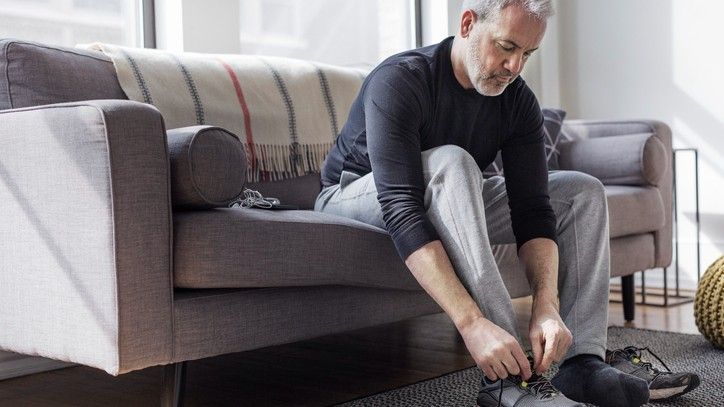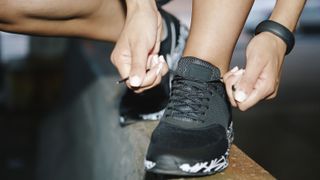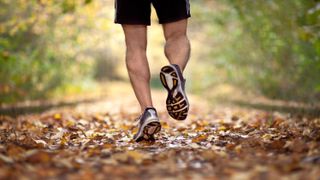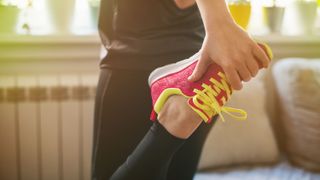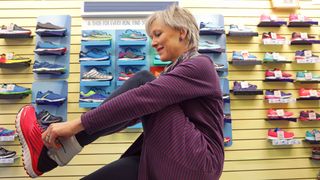Table of Contents
If you’re unsure how running shoes should fit we’ve got you covered. There’s more to running shoes than meets the eye and not doing due diligence early on can lead to discomfort and potential injury.
The ideal running shoe should feel snug around your heel and leave wiggle-room for your toes, with very little give around the ankle, for maximum support. You need to bear in mind that your left and right foot are likely to have different requirements, and that running shoes are not a one-size-fits-all thing.
We asked a physical therapist and run coach – and a Head of Biomechanics – to give us their advice on what to look for when buying new trainers.
Want more tips on running? Check out our articles on how to run properly or read our guide on what to eat before a run. Or if you need some suggestions on what gear to use, check out our round-ups of the best sports bras for running and best running watches.
How to check your running shoes fit
Shoe size
Before you choose a shoe you need to know your size. According to the American Orthopaedic Association, most women frequently guess their shoe size incorrectly, so it’s always worth checking – especially as your foot size changes with age.
A simple way to do this is to measure the width and length of your foot in centimeters or inches, then refer to a manufacturing guide to match your size. If you have one foot larger than the other, go with that [larger] foot.
“One of the easiest ways to determine shoe size is by taking out the factory insert of the shoe, placing it on the ground, and standing on it,” says Vikash Sharma, a physical therapist and certified running coach at Perfect Stride Physical Therapy. “If your foot can sit on top of the insole without spilling over the edges, you have a shoe that fits.”
Tightness
Running shoes should be half a size up from your regular shoe (when wearing socks) and feel snug around your heel and midfoot, with room to wiggle your toes. Ideally, you’re aiming for about a thumb width of space between the shoe and your big toe.
Remember, your feet swell during exercise, so bigger is better.
Heel support
We asked Dr Grant Trewartha – Head of Biomechanics at Nurvv – to take us through some basic heel checks.
“The heel should feel nicely locked into place during the stride (not slipping), and you should also make sure the toe box is wide enough to allow the toes to splay, somewhat naturally, during each step,” says Trewartha. ”If they have too much movement or not enough, you’ll put unnecessary pressure on specific points, which can lead to rubbing.”
A way to test movement is to hold the back of a running shoe and lift your heel. If your heel is slipping, then the shoe is too big.
Read more: How to start running
How to choose a running shoe
Your running shoe type depends on your foot shape, goals and experience.
“It’s always best to wear running shoes designed for the conditions and terrain you’ll be mostly running on,” says Trewartha. “Trail shoes are designed for mud, gravel, and uneven surfaces, whereas racing shoes aren’t going to be quite as appropriate.”
According to Trewartha, prioritizing your road surface means you can determine the amount of grip you will need on the outsole and the correct cushioning. He encourages runners to look for more cushioning on longer runs and favors responsive lightweight shoes for shorter, faster running.
“Consider the amount of support you are looking for – neutral, cushioned or motion control – as this is designed to limit excessive pronation [the way your foot rolls inward on landing],” he says.
If you’re a beginner, extra padding can go a long way to supporting your joints and help exercise without hurting your knees.
How running shoes should feel
”You should never think that a running shoe can be worn-in to fit your foot, it should fit well on day one,” says Sharma. “Ideally, we would like to see people in a zero-drop shoe – the heel sits at the same height as the toes; it will allow for your foot to function more like a foot should, and reduce forces through your joints by promoting a foot strike closer to your body.”
Sharma advises runners to take note of sensations, adding that, “If you have a positive association when first trying on your shoes, it has been shown that you will perform better in them.”
Trewartha adds that factors such as responsiveness and energy return will be crucial depending on whether you’re planning an ultramarathon or closing in on a sprint PB. It will also determine whether you pick a nylon or carbon plate.
“All shoes may need a run or two to “break-in”, but they should feel comfortable to wear straight out of the box, otherwise they may not be the shoes for you,” he says.
Supination vs pronation
Trewartha defines the terms by explaining that “pronation and supination are opposite motions of the foot that occur at different phases of ground contact. Pronation occurs during the initial “loading” phase of a step and can be viewed as the inward rolling of the foot.
Trewartha believes pronation is crucial as it contributes to absorbing the energy of the foot-ground impact.
“Supination is the outward rolling of the foot that occurs during the push-off phase of a step, contributing to propelling the body forward into the next flight phase,” he says.
Supination generally occurs when you have high foot arches, and many professionals (and some shoe stores) now offer gait analysis to determine this. Pronated runners will require trainers that offer plenty of stability to control inward movement, whereas supinated and neutral movers will require a neutral shoe.
Trewartha advises opting for shoes such as Saucony, as they support people who over or under pronate and can determine your shoe based on your running style.
Where to buy your shoes
You may find that buying online gives you access to cheaper deals on running shoes. It’s quick and easy, though you are restricted from trying the shoe on – which is fine if you know what you want, and less so if you’re still figuring it all out.
“For repeat purchases of your known favorite shoes, there’s no problem with going with an online retailer,” says Trewartha. “If you are new to running, or considering buying a make/model/type of running shoe you have not worn before, then it would be a good idea to visit a store to try before you buy.”
“I recommend buying your running shoes at a specialty running shoe store – they will have more knowledge about running shoes,” says Sharma. “Also, a skilled running physical therapist can help you find the shoe that best fits your running mechanics and movement capabilities.”
Some stores might offer you free gait analysis and shoe-size fittings, which you won’t get from your sofa!
https://www.livescience.com/how-running-shoes-should-fit
 fashion rec fashion wanted
fashion rec fashion wanted
